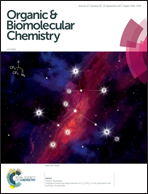 A chemistry journal has issued expressions of concern for three papers after a reader notified the editors of “unexplained discrepancies” in the data.
A chemistry journal has issued expressions of concern for three papers after a reader notified the editors of “unexplained discrepancies” in the data.
According to the notices, after the editors of Organic & Biomolecular Chemistry confirmed the problems, they contacted the corresponding author on the three papers, Pradeep Kumar—who works at the Council of Scientific and Industrial Research (CSIR)-National Chemical Laboratory in Pune, India—as well as the director of CSIR, Ashwini Kumar Nangia. The institution conducted its own internal review of the spectra and concluded the authors did not intentionally alter them.
Still, the journal and institution could not confirm the accuracy of the data, and the journal published expressions of concern to warn readers about the issues.
Here’s the expression of concern for “A general and concise asymmetric synthesis of sphingosine, safingol and phytosphingosines via tethered aminohydroxylation:”
It has been brought to the Executive Editor’s attention that there are a number of unexplained discrepancies (visible under magnification) in the NMR spectra presented in the ESI accompanying this article. These have been confirmed by independent review by a member of the Editorial Board.
The affected spectra are: 13C NMR spectra for; 16, 19, 20, 26, 39, 34, 35, 36 and 12; 1 H NMR spectra for; 26, 34, 35, 36 and 12.
Following consultation with the authors and the Director of CSIR-National Chemical Laboratory, we have established that archive copies of the original data supporting these spectra are no longer available for comparison. After carrying out an internal review the Director of CSIR-National Chemical Laboratory has determined that there was no intentional altering of the published NMR spectra.
However as the accuracy of these NMR spectra cannot be confirmed the Executive Editor is issuing this notice for readers’ information.
The 2010 paper has been cited 26 times, according to Clarivate Analytics’ Web of Science.
The language in the other two expressions of concern is identical, though both notices call out different spectra. The expression of concern for “Organocatalytic stereoselective synthesis of passifloricin A” highlights the affected spectra:
13C NMR for; 10, 11, 19, 20, 21 and 22, 1H NMR for; 13, 19, 20, 21, 22 and 1.
The 2012 paper has been cited 18 times.
The expression of concern for “Enantio- and diastereocontrolled conversion of chiral epoxides to trans-cyclopropane carboxylates: application to the synthesis of cascarillic acid, grenadamide and L-(-)-CCG-II” highlights the affected spectra:
13C NMR spectra for; 11, 13, 17, 20, 15 and 21, 1H NMR spectra for; 17 and 21.
The 2012 paper has been cited nine times.
The nature of the errors isn’t entirely clear, nor why so many spectra were affected.
Richard Kelly, the executive editor at the Royal Society of Chemistry, which publishes the journal, told us:
These were not picked up during peer review as they were only evident under high magnification.
We contacted Kumar as well as Nangia for more information, but neither responded.
Earlier this year, we reported that the same journal had decided to swap a 2015 expression of concern with a correction notice, after the authors addressed the editors’ concerns in a follow-up paper.
Like Retraction Watch? Consider making a tax-deductible contribution to support our growth. You can also follow us on Twitter, like us on Facebook, add us to your RSS reader, sign up on our homepage for an email every time there’s a new post, or subscribe to our daily digest. Click here to review our Comments Policy. For a sneak peek at what we’re working on, click here.
“Still, the journal and institution could not confirm the accuracy of the data, and the journal published expressions of concern to warn readers about the issues.”
And, from the retraction notice:
“Following consultation with the authors and the Director of CSIR-National Chemical Laboratory, we have established that archive copies of the original data supporting these spectra are no longer available for comparison.”
The editors in this case did the right thing by issuing expressions of concern.
Not being able to produce the original data underlying figures in 5-7 year old papers is very serious.
Alerting the readers is the absolute right thing to do.
The 13C NMR spectral prints in the supporting information contain peaks for impurities which have been covered with white squares. Actually they can be identified (by “select all”) and removed in Acrobat, and the impurity peaks are revealed (the spectra are present in vector format in the PDF file).
So there is no need for the original data to prove that the spectra have been modified (in the sense of: “beautified”, by pretending higher purity of the products).
A bad case is compound 12 in the first paper, where the covered peaks are of the same intensity like the peaks of the actual compound. This implies that the synthesis does not give pure products, and instead of solving the selectivity problems of the synthesis, the impurities have been covered “digitally”.
In any case a clear breach of good working practices.
Ihac,
Well analyzed!
The editors certainly would have been justified in retracting.
This option was short circuited by the institution, who gave the authors a pass.
According to COPE when an ethical issue is raised by the journal and an unsatisfactory response from the institution is given the article gets an expression of concern.
I’ve always felt that an EoC is in some ways worse than a retraction because it signals a failure of both the authors and the institution.
Worse yet is when the authors, institution and the journal fail to alert the readers of possible concerns with the data.